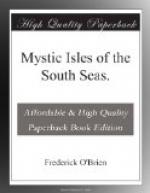Naula-a-Maihea of Oahu, not far from Honolulu, was upset from his canoe while paddling to Kauai, and was swallowed by a whale, which kindly threw him up on the beach of Wailua.
Kana-loa and Kane-Apua, prophets, walked about the world, causing water to flow from rocks, as did Moses, and in the ancient litany, recited by priest and congregation, the responses of “Hooia, e oia!” meant “It is true!” as does Amen, the response of Christian litanies to-day. The custom of using holy water prevailed all over Polynesia.
“The ocean which surrounds the earth was made salt by God so it should not stink,” said the legend, “and to keep it salt is the special work of God.”
To celebrate God’s act, the priests of Polynesia blessed waters for purification, for prayer, and for public and private ceremonies, and to exorcise demons and drive away diseases, as the priests of America and Europe do. Holy water was called ka wai kapu a Kane, and from the baptizing of the new-born child to the sprinkling of the dying its sacred uses were many. To-day the older people use these pagan ablutions to alleviate pain and cure maladies. The old Greeks used salt water for the same purposes, and had holy-water fonts at the temple gates, as do the Catholic churches to-day.
Levy and Woronick believed, or pridefully affected to believe, that at a remote period a band of Israelites, perhaps one of the lost tribes carried away by the Assyrians, peopled these islands; or settled in Malaysia before the Polynesian exodus from there, and gave them their lore. Pere Rambaud of the Catholic mission at Papeete considered it more probable that Spaniards, reaching Hawaii from wrecked Spanish galleons voyaging between Mexico and Manila, brought the holy doctrines. His explanation, however, often advanced, fell utterly before the fact that the Polynesians had no knowledge of Jesus or any man or god like him, and knew nothing of original sin; but, more convincing, all Polynesia had these legends, and there had been no communication with the Maoris of New Zealand and with Fiji after the Spanish entered the Philippines. It is to me quite certain that the Polynesians brought with them from Malaysia or India or from farther toward Europe those traditions of the beginnings of mankind which grew up hundreds of thousands of years ago, and were dispersed with each group setting out for adventure or driven from the birthplace of thinking humans.
Taaroa, whose name was spelt differently in separated archipelagos, was the father of the Tahitian cosmogony. His wife was Hina, the earth, and his son, Oro, was ruler of the world. Tane, the Huahine god, was a brother of Oro, and his equal, but there were islands which disputed this equality, and shed blood to disprove it, as the sects of Christianity have since the peaceful Jesus died by the demands of the priests of his nation.
Haui was the Tahitian Hercules. Of course he, too, bade the sun to stay a while unmoving, and it did. Joshua, the son of Nun, whose astronomical exploit at Gibeon brought him immortal fame, was a glorious warrior; but Haui’s unwritten achievements, as chanted by the orero at the marae where Tetuanui, Brooke, and I stood, would have forced the successor of Moses to have withdrawn his book from circulation, as too dull.




